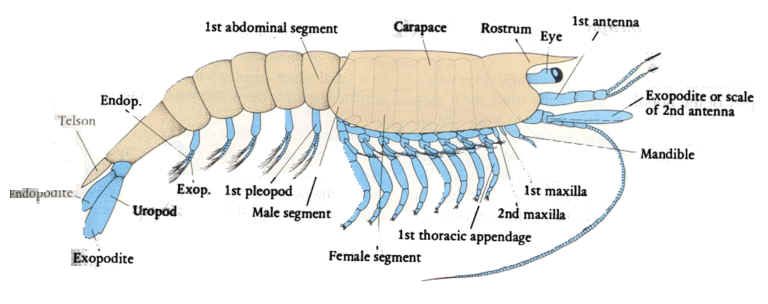Important Subphylum in which arthropoda phylum is divided are mentioned below:
1. Subphylum: 1
Trilobita: (Gr; tri, three + lobos, lobe)
ADVERTISEMENTS:
(i) They are most primitive arthropods. Mostly marine and bottom dwellers.
(ii) Found in cambrian to permian era.
(iii) Body 3 lobed, due to 2 long longitudinal furrows Body is covered by a hard segmented shell.
ADVERTISEMENTS:
(iv) Abdominal region of 2 to 29 somites and a fused caudal plate or pygidium.
(i) Biramous appendages on all segments except the last one.
Example:
Triarthrus, Dalmanites etc.
ADVERTISEMENTS:
2. Subphylum -2
Chelicerata: (Gr; chele claw +keros, horn + tata, group)
(i) Body divided into an anterior cephalothorax (prosoma) and a posterior abdomen (opeisthosoma).
(ii) Prosomatic appendages 6 pairs. First pair of preoral chelicerae with claws followed by postoral pedipalps and 4 pairs of walking legs.
(iii) Respiration by gills, book lungs, and tracheae.
(i) Excretion by malpighian tubules or coxal glands or both.
Class 1:
Merostoma
(i) Marine cephalotherax with lateral compound eyes and six pairs of usual appendages.
(ii) Abdomen with 5 to 6 pairs of gill bearing appendages. Respiration is by these book-gills.
(iii) Abdomen ending in a sharp telson or spine.
(iv) Excretion by coxal glands.
Example:
Limulus (king crab), Eurypterus etc.
Class 2:
Arachnida (Gr; Arachne; spider)
(i) Terrestrial or aquatic. Eyes simple.
(ii) Respiration by book lungs or tracheae.
(iii) Abdomen without appendages.
(iv) Many with poison glands, poison fangs, stings etc.
(v) Usually spiders, scorpions, mites, tick etc.
Example:
Palamneaeus (scorpion), Lycosa (spider), Ixodes etc:
Class 3:
Pycnogonida or pentapoda
(i) Small sized marine spiders.
(ii) Cephalothorax 3 segmented, abdomen vestigeal.
(iii) Suctorial mouth on top of a long proboscis.
(iv) Head usually with 4 pairs of appendages and 4 eyes.
(ii) No special respiratory or excretory organs.
Example:
Nymphon, Pycnogonum etc.
3. Subphylum 3:
Mandibulata or Antennata (L. Mandibulata, mandible + ata, group)
(i) Body divisible into head, thorax and abdomen.
(ii) Cephalic region has 1 or 2 pairs of antennae 1 pair of jaws or mandibles and 1 or 2 pairs of maxillae.
(iii) Compound eyes commonly found.
Class 1:
Crustacea
(i) Mostly aquatic. Body is divided into cephalothorax and abdomen.
(ii) Dorsally cephalthorax covered by a thick exoskeletal carapace.
(iii) Appendges are typically biramous.
(iv) Abdominal somites usually distinct with a posterior telson.
(v) Respiration through body surface or by gills.
(vi) Development involves nauplius larva.
Example:
Palaemon, Cancer, Cyclops etc.
Class 2:
Insect: (L. insectus, cut or divided)
(i) Body made of head (6 fused segments) thorax (3 segments) and abdomen (upto 11 segments).
(ii) Head with compound eyes (1 pair), antennae (1 pair), mandibles (1 pair) and maxillae (2 pairs).
(iii) Thorax with typically 3 pairs of jointed legs and one or 2 pairs of wings may or may not be present.
(iv) Respiration by branched tracheae.
Example:
Periplanata, Musca, Mosquitos etc.
Class 3:
Diplopoda:
(i) Terrestrial. Body, long, cylindrical and worm like.
(ii) 5 segmented head with 1 pair, of short antennae, mandibles and maxillae.
(iii) Thorax bears 4 segments, each except the first segment with a pair of jointed legs.
(iv) Abdomen 9 to 100 or more segments each bears 2 pairs of legs, spiracles ostia and nerve ganglia.
(v) Respiration by tracheae.
(vi) Excretion by malpighian tubules.
Examples:
Thyroglustus (millipede), Scolopendra, Lithobius etc
4. Subphylum 4:
Onychophora (Gr; onychos, claw + phoros, bearing)
(i) Terrestrial, primitive worm like unsegmented.
(ii) Single pair of antennae, eyes and jaws.
(i) Numerous stumpy, unjointed clawed legs.
Examples:
Peripatus.

